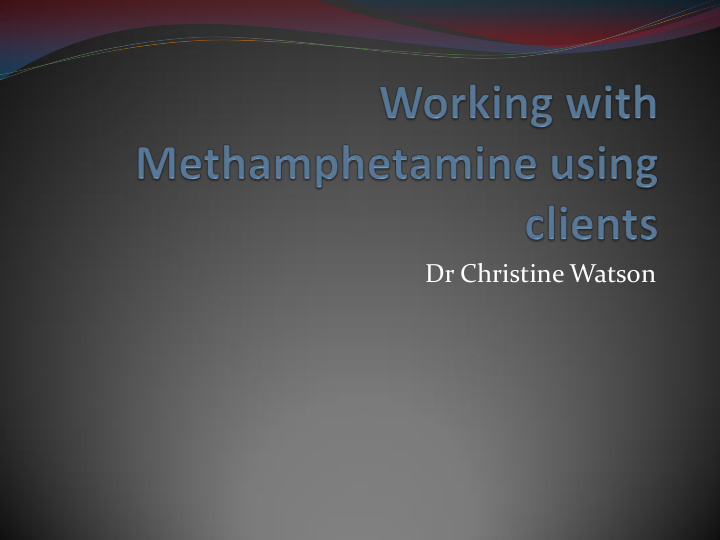



Dr Christine Watson
Sticky/oily/waxy form Powder – speed, whiz, velocity Base, paste, point, pure, wax - Usually snorted, ingested or injected - 20% pure - Generally produced locally - most common - usually injected or swallowed (can be - Approximately 10% purity smoked/snorted) - Generally produced locally
Ice Crystal meth, Shabu, Glass Purity close to 80% Suitable for inhalation or injection or intranasal Smoking is highly dependence forming (and possibly comparable to injecting) Inject safely
Prevalence of Drug Use Table 5.3: Summary of recent (a) illicit use of drugs, people aged 14 years or older, 1993 to 2013 (per cent) Drug 1993 1995 1998 2001 2004 2007 2010 2013 Illicit drugs (excluding pharmaceuticals) Cannabis 12.7 13.1 17.9 12.9 11.3 9.1 10.3 10.2 Ecstasy (b) 1.2 0.9 2.4 2.9 3.4 3.5 3.0 2.5# Meth/amphetamines (c) 2.0 2.1 3.7 3.4 3.2 2.3 2.1 2.1 Cocaine 0.5 1.0 1.4 1.3 1.0 1.6 2.1 2.1 Hallucinogens 1.3 1.9 3.0 1.1 0.7 0.6 1.4 1.3 Inhalants 0.6 0.4 0.9 0.4 0.4 0.4 0.6 0.8 Heroin 0.2 0.4 0.8 0.2 0.2 0.2 0.2 0.1#
How Frequently? Table 5.11: Frequency of drug use, recent (a) users aged 14 years or older, by sex, 2010 to 2013 (per cent) Males Females Persons Frequency of use 2010 2013 2010 2013 2010 2013 Meth/amphetamines (b) At least once a week or more 10.3 13.0 *7.8 20.1# 9.3 15.5# About once a month 15.7 16.9 15.4 16.1 15.6 16.6 Every few months 27.2 23.4 24.9 13.5# 26.3 19.8 Once or twice a year 46.8 46.8 51.9 50.3 48.8 48.0 48% use once a year – target group
Trends in Summary No increase in overall prevalence Those that are using - using crystal (ICE) form - increase potency - increase frequency - increase harms Injecting weekly or binging leads quickly to dependence
What form? Table 5.19: Form of meth/amphetamine (a) used, recent (b) users aged 14 years or older, 2007 to 2013 (per cent) Form of drug 2007 2010 2013 Main form used Powder 51.2 50.6 28.5# Liquid 1.3 **0.9 **0.5 Crystal, ice 26.7 21.7 50.4# Base/Paste/Pure 12.4 11.8 *7.6 Tablet 5.1 8.2 *8.0 Prescription amphetamines 3.2 6.8 *3.0# Capsules n.a. n.a. *2.0
Drug use compared to the rest of Australia Alcohol is our biggest problem
Group is hard to engage in treatment Users are more commonly: - Young 20-29 - most likely male Very few regular heavy methamphetamine users seek treatment (1 in 10)
Longterm outcome At 3yrs, 10% of dependent users will be dead or in prison In the short term people who had treatment used less and had less harm – however these effects gone by 3yrs In 3yrs, 1/3 dependent users will be abstinent regardless of having had treatment or not Drug addiction is a chronic relapsing condition
Treatment Brief interventions, an assessment, assertive follow up, self help booklets “ detox ” Residential rehabilitation CBT/DBT Pharmacological treatment Harm reduction measures apply (needle exchange, clean water, take home naloxone, safe injecting rooms) Co-morbidities including complications and psych
Business as usual? MA Rehab in Australia MATES study 2012 Addiction (112 withdrawal, 248 rehab) - Withdrawal – no effect size at any follow up - Rehab – large reductions at 3 months but very attenuated at 3 years
Psychological Treatments Contingency Management Used in US (rarely in Australia) - Involves rewarding the patient with vouchers/cash/other - for achieving goals, often a negative urine - Strong efficacy (possibly up to a doubling in quit rate) across many drug types including MA - long term studies rare and relapse once contingency removed may occur CBT/DBT/group work Motivational Interviewing And combinations of the above
Pharmacological Treatments chronic stimulant use results in dopamine depletion Could dopamine agonists be effective? No - bromocriptine, amantadine and pergolide all negative What about levadopa itself? No Indirect Dopamine agonists? - essentially stimulant like compounds which act as a ‘substitution’ therapy similar to methadone for heroin - Dexamphetamine, methylphenidate, modafanil , naltrexone- trialed with mixed results • Depression and associate psychosis do respond reasonably; - Mirtazapine and olanzapine
AOD services NT – core business Education Triage and assessment Hospital liaison, ED workers Detox/withdrawal management Referral to other residential programs Remote community outreach Psychological therapy Harm reduction Treatment is available
Methamphetamine specific services- some things are different High rates of violence and out of character violence – shame Episodic cravings and long duration of withdrawal Mental health consequence – psychosis Cognitive profile as a consequence of use Service adaptions...... “Teachable moments” – in detox/ED/RDH Methamphetamine clinics – trial modafanil Prison in reach
Management strategies: Different strategies for different presentations intoxicated – generally fit males - don’t engaged in lengthy interviews or counselling sessions, limited clear information allowing them time to vent their frustration Psychotic – paranoid and fearful – don’t laugh/argue/stare ? Mental health assessment Withdrawing - irritable, impulsive, ? Start your conversations
General Principals- need workplace specific approach on how to deal with aggressive/intoxicated individuals Safety – quiet, clear, you near the exit, duress alarms, training P3, rules around consulting alone, give space De-escalation- calm, non threatening, reduce volume and pace of speech, confident Communication – clear, simple, repetitive, limited information depending on situation Be the service that they may come back to when in trouble
Reasons why people continue to use illicit drugs, recent (a) meth/amphetamine and any illicit drug users, people aged 14 years or older 2013 (per cent) amph any drug Influence of friends or family 6.1 9.4 Addiction/dependency 11.4 7.5 Wanting to improve mood/feel happy 16.7 10.6 Wanting to do something exciting 20.9 16.7 Wanting to enhance experiences 26.6 31.7 Enjoyment/it's fun 0.9 3.9 Other 14.2 17.5 20.2
Ecstasy and Related Drugs Report use over the previous 6mths
Recommend
More recommend